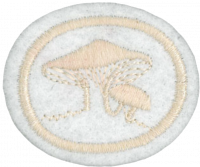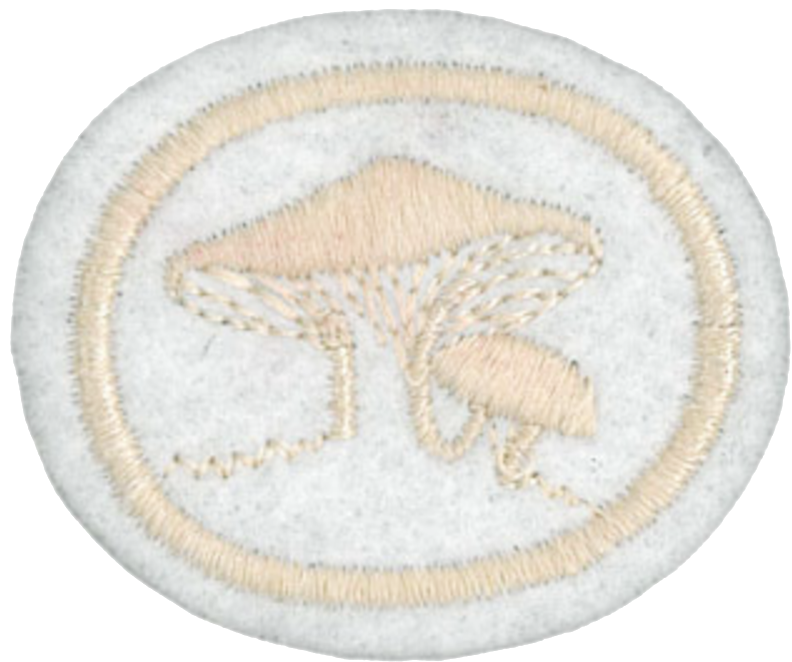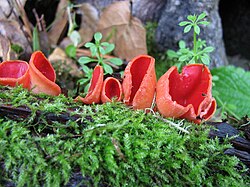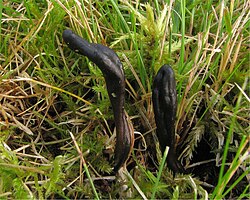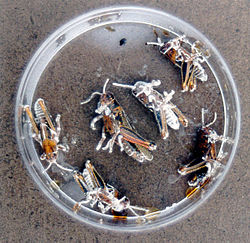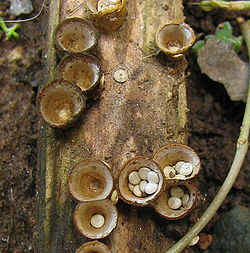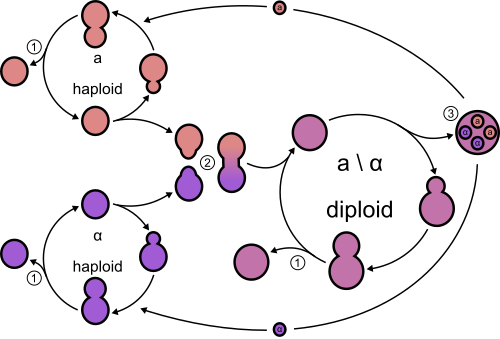Difference between revisions of "AY Honors/Fungi/Answer Key/en"
(Updating to match new version of source page) |
(Updating to match new version of source page) |
||
| Line 12: | Line 12: | ||
;Zygomycota: The zygomycetes, in phylum Zygomycota, are characterized by the formation of sexual spores called zygospores. The zygospores are not contained within a specialized fruiting body or sac. An example of a zygomycete is the common black bread mold, ''Rhizopus nigricans'', which spreads over the surface of bread and other food sources, sending hyphae inward to absorb nutrients. In its asexual phase it develops bulbous black sporangia at the tips of upright hyphae, each containing hundreds of haploid spores. These fungi have many industrial uses including ''Rhizopus'' used in tofu production and ''Blakeslea trispora'' which is used to manufacture beta-carotene for dietary supplements and other uses. | ;Zygomycota: The zygomycetes, in phylum Zygomycota, are characterized by the formation of sexual spores called zygospores. The zygospores are not contained within a specialized fruiting body or sac. An example of a zygomycete is the common black bread mold, ''Rhizopus nigricans'', which spreads over the surface of bread and other food sources, sending hyphae inward to absorb nutrients. In its asexual phase it develops bulbous black sporangia at the tips of upright hyphae, each containing hundreds of haploid spores. These fungi have many industrial uses including ''Rhizopus'' used in tofu production and ''Blakeslea trispora'' which is used to manufacture beta-carotene for dietary supplements and other uses. | ||
| − | [[File:Zygomycetes_on_solid_media | + | [[File:Zygomycetes_on_solid_media.png|200px]] |
;Glomeromycota: Members of the Glomeromycota are also known as the ''arbuscular mycorhizal fungi (AMF). This type of fungi is found on the roots of about 80% of vascular plants, where it helps the plant capture nutrients from the soil. The tremendous advances in research on mycorrhizal physiology and ecology over the past 40 years have led to a greater understanding of the multiple roles of AMF in the ecosystem. This knowledge is applicable to human endeavors of ecosystem management, ecosystem restoration, and agriculture. | ;Glomeromycota: Members of the Glomeromycota are also known as the ''arbuscular mycorhizal fungi (AMF). This type of fungi is found on the roots of about 80% of vascular plants, where it helps the plant capture nutrients from the soil. The tremendous advances in research on mycorrhizal physiology and ecology over the past 40 years have led to a greater understanding of the multiple roles of AMF in the ecosystem. This knowledge is applicable to human endeavors of ecosystem management, ecosystem restoration, and agriculture. | ||
Revision as of 13:00, 28 May 2021
1
There are about 32 classes of fungi, not including subclasses. Here are some examples:
- Chytridiomycetes
- The chytrids, represents a group of primitive aquatic fungi. They are characterized by having reproductive cells can move themselves by using whip-like tails called flagella. Synchytrium endobioticum is a chytrid fungus that causes the potato wart disease or black Scab.
Batrachochytrium dendrobatidis, discovered in 1998 in Australia and Panama, and causes a disease that kills amphibians in large numbers and has been suggested as a principal cause for the worldwide amphibian decline. Outbreaks of the fungus were found responsible for killing much of the Kihansi Spray Toad population in its native habitat of Tanzania, as well as the extinction of the golden toad in 1989.
- Zygomycota
- The zygomycetes, in phylum Zygomycota, are characterized by the formation of sexual spores called zygospores. The zygospores are not contained within a specialized fruiting body or sac. An example of a zygomycete is the common black bread mold, Rhizopus nigricans, which spreads over the surface of bread and other food sources, sending hyphae inward to absorb nutrients. In its asexual phase it develops bulbous black sporangia at the tips of upright hyphae, each containing hundreds of haploid spores. These fungi have many industrial uses including Rhizopus used in tofu production and Blakeslea trispora which is used to manufacture beta-carotene for dietary supplements and other uses.
- Glomeromycota
- Members of the Glomeromycota are also known as the arbuscular mycorhizal fungi (AMF). This type of fungi is found on the roots of about 80% of vascular plants, where it helps the plant capture nutrients from the soil. The tremendous advances in research on mycorrhizal physiology and ecology over the past 40 years have led to a greater understanding of the multiple roles of AMF in the ecosystem. This knowledge is applicable to human endeavors of ecosystem management, ecosystem restoration, and agriculture.
- Ascomycota
- They are also called the “sac fungi” because their sexual spores (ascospores) are enclosed in tube-like sacs known as asci. This group is of particular relevance to humans as sources for medicinally important compounds, such as antibiotics and for making bread, and cheese, but also as pathogens of humans and plants, and for making alcoholic beverages. Familiar examples of sac fungi include morels, truffles, brewer's yeast and baker's yeast, Dead Man's Fingers, cup fungi, and the majority of lichens (loosely termed "ascolichens") such as Cladonia."
- Agaricomycetes
- This class includes the fungi commonly called mushrooms including the common fairy-ring mushroom, shiitake, enoki, oyster mushrooms, fly agarics and other amanitas, magic mushrooms like species of Psilocybe, paddy straw mushrooms, shaggy manes, puffballs etc.
- Geoglossomycetes
- A fungi broadly known as earth tongues. The ascocarps of most species in the family Geoglossaceae are terrestrial and are generally small, dark in color, and club-shaped with a height of 2–8 cm. The ascospores are typically light-brown to dark-brown and are often multiseptate. Other species of fungi have been known to parasitize ascocarps. Earth tongues are commonly found in soil or among rotting vegetation. In North America, they are commonly found in coniferous woodland, broad-leaved woodland and mixed woodland habitats, whereas in Europe they are commonly found in grassland habitats.
All fungi lack chlorophyll, the substances that allows plants to make their own food through photosynthesis. Instead, fungi get food from decaying plant or animal matter, through symbiosis or in the case of parasitic fungi, from living plants or animals. While we often think of mushrooms as a synonym for fungi, there are only about 10-20,000 species of mushrooms out of an estimated 1,500,000 species of fungi, the majority being inconspicuous or microscopic. Only about 80,000 species of fungi are named. (Source: The North American Guide to Common Poisonous Plants and Mushrooms, Turner & von Aderkas, pg 63)
2
The best way to approach this requirement like all similar nature honor requirements, is to go out looking for fungi, and then try to figure out what you have found. This is far more effective than studying your field guide, deciding what you want to look for, and then going out for a look while walking past other fungi you could be identifying. Also remember the requirement says fungi, so open your eyes to fungi other then mushrooms. It should be easy to find, photograph and identify 15 common fungi if you take your camera whenever you are out walking or hiking anyway. Fungi help decompose rotting stumps and logs, and like moisture, so search appropriately. Look up too, not just down, for some fungi grow on the sides of trees. In the kitchen and garden you might also look for black mold (will mom let you leave some bread out?) and yeasts.
For identify fungi outdoors, you will need a field guide (book or online). The field guide you select should cover the area where you are looking for fungi. For example, a field guide to the mushrooms of Australia is not going to help you very much if you're looking for fungi in North America.
Once you have a field guide, take it, plus your camera or sketch pad, and go out looking for fungi. When you find one, try to figure out what it is using your field guide. It is difficult to distinguish the various species of fungi from photographs alone, so you will want to identify it on the spot. Many times the identification of a species will rely on an obscure feature such as the gills on the underside of a mushroom. Chances are, if you attempt to identify the fungus later from a snapshot, you will not have captured one of the critical identifying features, or the feature was not sufficiently in focus. That is why you will want to make an identification when you have direct access to the specimen. If you find yourself looking at an interesting specimen and do not have your field guide with you, by all means, sketch it out and take photos. There is always the chance that you will be able to identify it later. Take special notice of the gills (if there are any), how they attach to the stem, and any "fringes" around the stem.
3
Here are 5 example fungi used directly for food, as an agent to make food and alcohol, for industrial purposes, for medicine, and as a biological insecticide in farming.
- Agaricus bisporus is an edible basidiomycete mushroom native to grasslands in Europe and North America. When immature and white, this mushroom may be known as common mushroom, button mushroom, white mushroom, cultivated mushroom, table mushroom, and champignon mushroom. When immature and brown, this mushroom may be known variously as Swiss brown mushroom, Roman brown mushroom, Italian brown, Italian mushroom, cremini or crimini mushroom, brown cap mushroom, or chestnut mushroom. When mature, it is known as Portobello mushroom. A. bisporus is cultivated in more than seventy countries, and is one of the most commonly and widely consumed mushrooms in the world. When people think of a mushroom, this is usually the mushroom that comes to mind first.
- Saccharomyces cerevisiae
- Perhaps the most useful yeast, having been instrumental to baking as well as wine making and brewing since ancient times. It is the principal source of nutritional yeast and yeast extract ahd is believed to have been originally isolated from the skin of grapes.
- Aspergillus niger
- Better known as A. niger or black mold it commonly spoils fruits and other foods, but this fungus has beneficial uses too. It is used to make citric acid commercially, and it also can be used to make gluconic acid. Both are important food additives. Many useful enzymes are produced using industrial fermentation of A. niger. For example, A. niger glucoamylase is used in the production of high fructose corn syrup, and pectinases are used in cider and wine clarification. Alpha-galactosidase, an enzyme that breaks down certain complex sugars, is a component of Beano and other products that decrease flatulence It is used for food safety as a challenge organism for cleaning validation studies performed within sterile manufacturing facilities.
- Penicillium chrysogenum
- This is the organism that makes penicillin, from which the majority of the large class of beta-lactam antibiotics are derived. Penicillin and its derivatives have saved countless lives since they were discovered and isolated, starting in the 1940s.
- Beauveria bassiana is used as a biological insecticide to control a number of pests such as termites, thrips, whiteflies, aphids and different beetles. Its use in the control of bedbugs and malaria-transmitting mosquitoes is under investigation. Other fungi hold promise for their ability to attack selected insects without hurting other organisms or the plants that the farmer is trying to protect. Here are grasshoppers killed by B bassiana.
4
4a
4b
Penicillium chrysogenum is a mold that is widely distributed in nature, and is often found living on foods and in indoor environments. It is the source of several β-lactam antibiotics, most significantly penicillin.
Like the many other species of the genus Penicillium, P. chrysogenum reproduces by forming dry chains of spores (or conidia) from brush-shaped stalks called conidiophores. The conidia are typically carried by air currents to new colonization sites. In P. chrysogenum the conidia are blue to blue-green, and the mold sometimes exudes a yellow pigment. However, P. chrysogenum cannot be identified based on color alone. Observations of morphology and microscopic features are needed to confirm its identity.
4c
Bird's nest fungi are fungi with fruiting bodies that look like egg-filled birds' nests and make up the order the Nidulariales.
They are often seen on decaying wood and in soils enriched with wood chips or bark mulch. Cyathus striatus is probably the most commonly encountered species in the temperate northern hemisphere.
The "eggs" are spore cases called peridioles. Peridioles contain glebal tissue, basidia (a microscopic, spore-producing structure), and basidiospores (a reproductive spore), and are dispersed by rain. The nests are splash cups. When a raindrop hits one at the right angle the walls are shaped such that the eggs are expelled a good distance from the nest. Each egg has a sticky trailing thread attached to it. If that thread encounters a twig on its flight the egg will swing around and wrap itself around the twig. The spores can then germinate there and start the life cycle over again.
4d
Yeasts have asexual and sexual reproductive cycles; however the most common mode of vegetative growth in yeast is asexual reproduction by budding or fission. Here a small bud, or daughter cell, is formed on the parent cell. The nucleus of the parent cell splits into a daughter nucleus and migrates into the daughter cell. The bud continues to grow until it separates from the parent cell, forming a new cell. The bud can develop on different parts of the parent cell depending on the genus of the yeast.
Under high stress conditions haploid cells will generally die, however under the same conditions diploid cells (cells containing a full set of chromosomes) can undergo sporulation, entering sexual reproduction (meiosis) and producing a variety of haploid spores (which have only a half-set of chromosomes), which can go on to mate (conjugate), reforming the diploid.
5
Fusarium oxysporum
Adventist Youth Honors Answer Book/Nature/Fungi/Fusarium oxysporum
Downy mildew
Adventist Youth Honors Answer Book/Nature/Fungi/Downy mildew
Botrytis (Leaf blight, Neck rot)
Adventist Youth Honors Answer Book/Nature/Fungi/Botryotinia
Alternaria alternata
Adventist Youth Honors Answer Book/Nature/Fungi/Alternaria alternata
Smut
Adventist Youth Honors Answer Book/Nature/Fungi/Smut
Magnaporthe grisea
Adventist Youth Honors Answer Book/Nature/Fungi/Magnaporthe grisea
6
Mushrooms
Harvesting wild mushrooms is an age-old practice and remains an important economic activity around the world. However, there are poisonous mushrooms that look much like edible mushrooms. Be sure to have your pick checked by an experienced mushroom expert or buyer before consuming anything you pick. Better yet, don't pick and eat wild mushrooms at all (unless you are a trained professional).
According to the excellent book The North America Guide to Common Posionous Plants and Mushrooms, there are about 100 known poisonous species out of about 5000 named species of mushrooms in the United States. One third to one half of mushroom taxa in the USA remain unidentified and many of the identifed species are not gathered for food and have not been tested for toxicity. The situation in other parts of the world is even worse, where there is often a very limited understanding and no local guides to what mushrooms grow there. Relying on a North American or European guidebook in another region could prove deadly since toxicity levels between similar looking mushrooms vary around the world.
Also be aware that mushrooms can be introduced to new regions, often unwittingly brought in soil with nursery stock.
If you suspect mushroom poisoning (which may manifest hours after consuming mushrooms), seek immediate medical attention. Bring a sample of the mushroom to the hospital and call a poison control center. Globally, over 50% of mushroom poisonings are fatal, but with good medical care and prompt attention over 90% of victims recover in North America.
Mold
Flood conditions contribute to the growth and transmission of many kinds of fungi, some of which can cause sickness. Cleanup workers are at increased risk of exposure to airborne fungi and their spores because they often handle moldy building materials, decaying vegetable matter, rotting waste material, and other fungus-contaminated debris. The fungal material is carried into the respiratory tract when airborne particles are inhaled.
There are many different kinds of fungi, including mildew, molds, rusts, and yeasts. Most of these are harmless, but some can cause respiratory and other disorders when workers inhale or come into contact with fungi. Inhalation is the route of exposure of most concern to flood cleanup workers. The recommendations below offer strategies for workers renovating flooded buildings, homes, and structures to protect themselves while handling building materials that are visibly contaminated with fungi.
For workers cleaning up flooded buildings, homes, and other structures, excessive moisture or water accumulation indoors will encourage the growth of the fungi that are already present. Some fungi have the potential to cause adverse health effects such as allergic responses and asthma attacks. Individuals who are sensitive to molds may have signs and symptoms of allergic reactions such as nasal stuffiness, eye irritation, and wheezing. These individuals should minimize fungal exposure by wearing respirators, gloves, and eye protection. They should also seek to eliminate fungi, as described below. In addition, repeated or prolonged contact of the skin with flood water and continuous sweating can lead to fungal skin infections. These can be minimized or avoided by washing the skin with warm, soapy water and keeping it as dry as possible.
If a person experiences severe allergic or skin symptoms, or severe flu-like symptoms, he or she should seek medical advice. A health care provider can determine whether medication or any other precautions are necessary.
Tips to Remember
For anyone who may be exposed to mold and fungi:
- Avoid breathing dust (fungal spores) generated by moldy building materials, crops, and other materials.
- Consider using a disposable respirator as a minimum when working with moldy or damp hay, grain, compost, or building materials.
- Consider discarding all water damaged materials. Articles that are visibly contaminated with mold should be discarded. When in doubt, throw it out.
- Surfaces that have a light covering of mold should be scrubbed with warm, soapy water and rinsed with a disinfectant made of 1/2 cup liquid household bleach mixed into one gallon of water.
- CAUTION: Do not mix bleach with other cleaning products that contain ammonia.
- After working with mold-contaminated materials, wash thoroughly, including the hair, scalp, and nails.
- If the safety of food or beverage is questionable, throw it out. Only drink safe drinking water that has been bottled, boiled, or treated until there is confirmation that the community water supply is safe for consumption.
For additional information concerning fungi, health effects, and addressing flood damaged materials, please visit OSHA’s Safety and Health Topics web page on Molds and Fungi at: http://www.osha.gov/SLTC/molds/index.html
References
- http://www.caes.state.ct.us/PlantPestHandbookFiles/pphO/pphonio.htm
- http://www.osha.gov/OshDoc/data_Hurricane_Facts/Bulletin3.pdf
- Boundless. “Importance of Fungi in Human Life.” Boundless Biology. Boundless, 21 Jul. 2015. Retrieved 30 Sep. 2015 from https://www.boundless.com/biology/textbooks/boundless-biology-textbook/fungi-24/importance-of-fungi-in-human-life-153/importance-of-fungi-in-human-life-601-12945/
